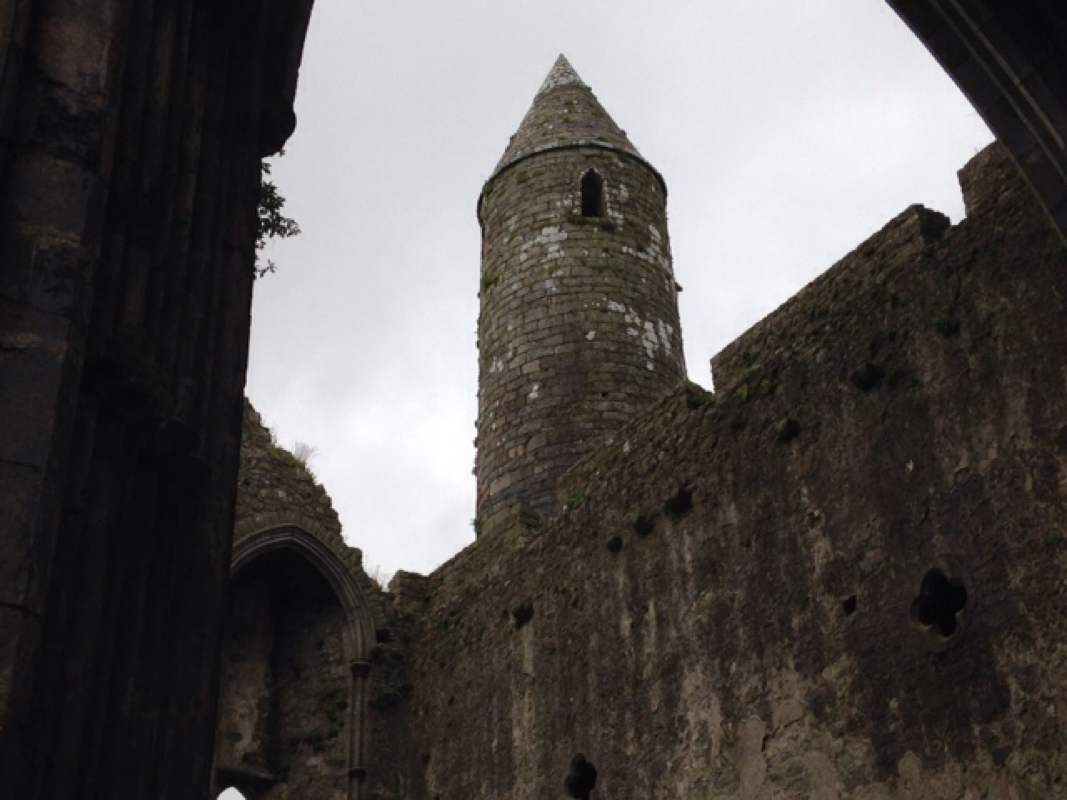|
Our troop of Irish tourists, all four of us, left Valentia Island on Saturday morning (July 11, Feast of St. Benedict) and crossed the country by car to Dublin, about a four-hour drive on the major expressways M8 and M7. I feel like an extra in a James Bond movie when I see those signs. We did make two stops, for a lunch and bakery purchase-brown Irish bread is my favorite so far--and a second one on the mount overlooking Cashel, site of an enormous castle/church/monastery that has fallen into disrepair. I included one picture on today's post before my phone screamed-"no space available." But, as I learned in Italy a few years ago, amateur photos rarely do justice to massive structures and impressive art. (However, they do serve adequately for bragging on Facebook.) Yesterday being Sunday, we found a church just around the corner from our apartment rental. This was a Carmelite oratory with an 8 AM Mass. As you may remember, I was not overly inspired by last week's Mass; this week's experience in Dublin was mildly improved. The celebrant spoke at greater length and did work to include the three readings. Or so I was told...between my deafness, the brogue, and the celebrant's tendency to speak faster than his sound system, I was able to gather in about every fourth word, so I took away a message that was probably different from what the general congregation received. What intrigued me again was an absence of any sense of "rite." This Mass, much like the other last week, was a good example of the medieval principle "ex opere operato," that is, say the right words and the sacrament "works." The non-sermon parts of the Mass were executed as "things to be gotten through" interspersed with the Hail Mary and even the Angelus. Again this week, there was no music (I can live with that, shame on me) and no kiss of peace. Communion, as one might expect, was under one form only. There were later Masses scheduled for 10, 11, and 12, a timetable that would never work in most U.S. settings where most celebrants acknowledge the importance of a worshipping community exercising a baptismal right of active and engaged worship. This oratory is located quite near St. Stephen's Green. Downtown in the shopping district is another Carmelite Church, St. Teresa's, where a later Mass was in progress and a homily about the Pope's encyclical. What intrigued me, though, was a large sign advertising the parish's coffee shop, open all day Monday through Saturday. It does not hurt that St. Teresa's is located off Grafton Street, a shopper's paradise, but the concept is an intriguing one to me, and I must get back and look at this concept closely before leaving Dublin. The grand experience of the day yesterday was visiting Trinity College and seeing with my own eyes the Book of Kells, the famous early medieval rendering of the Gospels and a marvel of calligraphy, art and survival. The exhibit itself is state of the art, with examples of various pages blown up to back lit wall size displays for study and curators' commentary. The copyists worked scrupulously to transmit the Scripture accurately; my guess is that they were working from St. Jerome's Vulgate Latin translation, though it may be that Celtic translations were also at hand. One of the challenges of this project was spatial and narrative coordination between the copyists and the artists, who shared space on each page. In quest of accuracy, the copyists did not erase mistakes but developed code for what must have been common errors of the day (or, conceivably, they were improving existing translations; it is hard to say.) The copyist expansions created challenges for the illustrators; the curators point out that the illustrators on occasion had interpretive views that their pictures could illustrate as a visual commentary, so to speak. A few examples will suffice. Although reference to the second creation account (Chapter 2ff of the Book of Genesis) does not appear in the Gospels, imagery of man's confrontation with the serpent does appear in the illustrations along the pages, evidently at the initiation of the illustrator, possibly to bring home themes of human weakness, sin, and the fall. A rather bizarre illustration has proved difficult for modern scholars to decipher: there is a depiction of two rats consuming a round communion wafer. Animals play a highly symbolic role in early Christianity (think of St. George and the Dragon) and a number of theses have been put forward about the meaning behind these rodents. Other commentators in this particular exhibit wonder if this illustration is related to a desecration of the communion bread and contains some allusion to transubstantiation or real presence. Aside from the artistry and the reverence of the Gospels, the curators go to considerable length to explain the importance of symbol and myth in understanding the faith of a given age. I photographed several texts from displays for posting in future days, on the subject of integrating art and literature into theological/religious discussion. I learned a lot of other things today, too, as we were using a city shuttle bus with historical commentary all day long. I discovered that Bram Stoker's girlfriend had previously dated Oscar Wilde, that Jonathan Swift was bishop of St. Patrick's Cathedral, and that Rev. Swift endowed Dublin's first mental hospital. Who says travel is not educational? Comments are closed.
|
MORALITYArchives
June 2024
|

 RSS Feed
RSS Feed